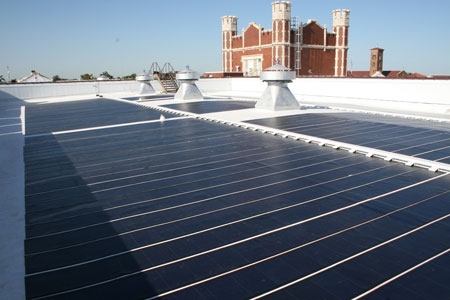Solar Panels
Solar panels are a collection of individual silicon cells that generate electricity from sunlight. The silicon cells convert sunlight directly into DC power. A component called an inverter converts this DC power into AC power that can be used in your home. The system is interconnected with your utility.
During the day, if your solar system produces more electricity than your home is using, your utility may allow net metering or the crediting of your utility account for the excess power generated being returned to the grid. Your utility would provide power as usual at night and during the day when your electricity demand exceeds that produced by your solar system. Systems are also available with a battery backup. Part of the power produced by your solar system during the day is used to charge the batteries, which provide power for your critical loads in the event of a power outage.gepower.com
Find out about Cradle-to-Cradle design
Radiant Heating
Radiant heating systems involve supplying heat directly to the floor or to panels in the wall or ceiling of a house. The systems depend largely on radiant heat transfer: the delivery of heat directly from the hot surface to the people and objects in the room via the radiation of heat, which is also called infrared radiation. Radiant heating is the effect you feel when you can feel the warmth of a hot stovetop element from across the room. When radiant heating is located in the floor, it is often called radiant floor heating or simply floor heating.eere.energy.gov
Water Reuse
To increase water efficiency at home reduce the use of drinkable water for non-consumption purposes. One way to do this is by reusing indoor wash water. You can install cisterns above or below ground that will collect and store run-off from rooftops and other impervious surfaces; as well as from laundry machines, dishwashers, bathtubs and sinks (this is classified as grey water, meaning that it does not include human waste or sewage).
These collection tanks can then serve as an on-site supply for watering your lawn and garden. It’s also possible to reuse grey water indoors in toilets and for washing, but the regulations and requirements are a bit more complex than for outdoor use. Regardless, there are varying degrees of treatment and filtration that can be installed in conjunction with your cistern, depending on what you intend to use the water for.inhabitat.com
Green Roofs
A green roof is a roof of a building that is partially or completely covered with vegetation and soil, or a growing medium, planted over a waterproofing membrane. It may also include additional layers such as a root barrier and drainage and irrigation systems. Green roofs are used to grow fruits, vegetables, and flowers, reduce heating (by adding mass and thermal resistance value) and cooling (by evaporative cooling) loads on a building, filter pollutants and CO2 out of the air, and increase wildlife habitat in built-up areas. wikipedia
Permaculture
Permaculture is more a set of practices than a set of products. Permaculture is about designing ecological human habitats and food production systems. It is a land use and community building movement which strives for the harmonious integration of human dwellings, microclimate, annual and perennial plants, animals, soils, and water into stable, productive communities. The focus is not on these elements themselves, but rather on the relationships created among them by the way we place them in the landscape. This synergy is further enhanced by mimicking patterns found in nature.
Energy-efficient buildings, waste water treatment, recycling, and land stewardship in general are important components of permaculture. More recently, permaculture has expanded its purview to include economic and social structures that support the evolution and development of more permanent communities, such as co-housing projects and eco-villages. As such, permaculture design concepts are applicable to urban as well as rural settings, and are appropriate for single households as well as whole farms and villages.attra.ncat.org
More Info
For more information on green building design, visit our Links & Resources page.




